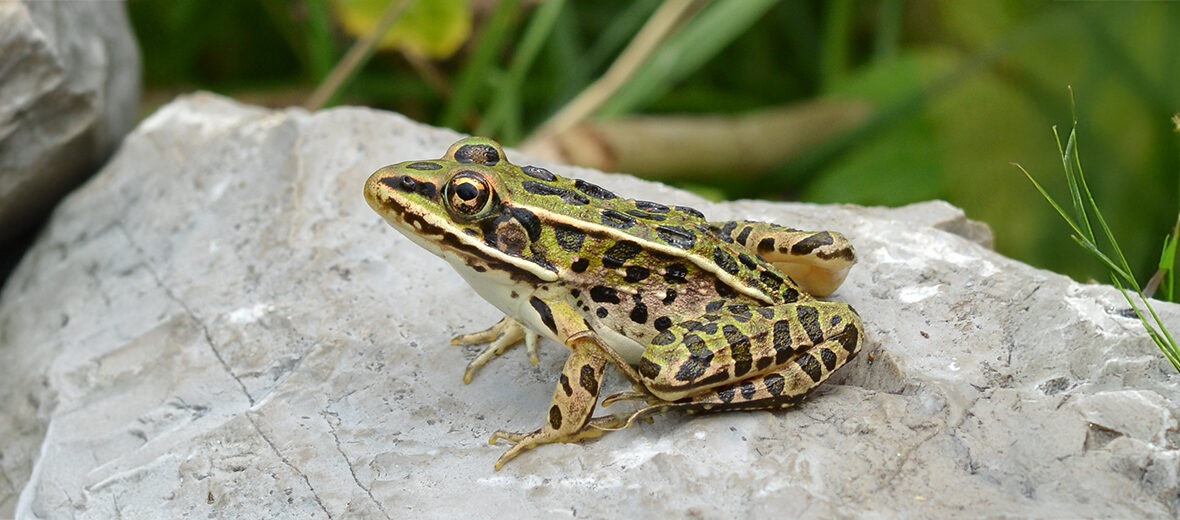
The northern leopard frog was recently renamed from Rana pipiens. These frogs can be found throughout Canada and the United States. Unfortunately, with such a wide distribution throughout North America they face many threats such as habitat loss at the hands of residential and commercial developments, farming, and ranching; hunting; trapping; invasive species, and with them disease & predation; and pollution, that can affect their water sources and food supplies. However, these frogs are abundant enough to be listed as Least Concern by the IUCN. Their populations are decreasing though.
First the Stats…
Scientific name: Lithobates pipiens
Weight: Up to 2.82 ounces
Length: Up to 4.3 inches
Lifespan: Up to 9 years
Now on to the Facts!
1.) These frogs have 3 color morphs: green, brown, and burnsi. The brown and green morphs typically possess the telltale spots on their back. The burnsi morph typically lacks the spots on their back but may or may not have them on their legs.
2.) Albinism (being born as an albino) and even blue morphs have been documented. But these are very rare.
3.) Part of their success is lended to their ability to tolerate a wide range of habitats such as permanent ponds, swamps, marshes, and slow-moving streams throughout forest regions, as well as open habitats, and urban areas.
4.) Having a high tolerance for cold weather, these amphibians can tolerate high altitudes of up to 9,800 feet.
5.) They produce a snore-like call, typically while wading in the water.
But wait, there’s more on the northern leopard frog!
6.) Breeding takes place from March – June.
7.) Females lay up to 6,500 eggs in the water.
Did you know…?
Northern leopard frogs are the state frog of Minnesota and Vermont.
8.) Tadpoles take up to 110 days to complete metamorphosis into adult frogs.
9.) These frogs were common throughout parts of western Canada and the U.S. until declines began occurring during the 1970s. Although not verified, habitat loss and fragmentation, environmental contaminants, introduced fish, drought, and disease have been suggested as mechanisms of decline and are likely preventing recovery in many areas. Many populations have not yet recovered from these declines.
10.) Snakes, raccoons, other frogs, and even humans all prey on these frogs.
But wait, there’s still more on the northern leopard frog!
11.) Northern leopard frogs don’t produce toxic skin secretions, so they instead depend on speed to avoid predation.
12.) Crickets, dragonflies, flies, worms, smaller frogs, birds, and smaller garter snakes are all on the menu.
Did you know…?
There was 1 instance of a bat being eaten by this species.
13.) Northern leopard frogs produce specific ribonucleases to their oocytes. These enzymes are potential drugs for cancer. 1 such molecule, called ranpirnase (onconase), is currently in clinical trials as a treatment for pleural mesothelioma and other lung tumors. Another, amphinase, has been described as a potential treatment for brain tumors.
14.) These frogs have been a favored species for making discoveries about basic properties of neurons as early as the 1950s. The neuromuscular junction of the sciatic nerve fibers of the sartorius muscle of these frogs have been the source of initial data regarding the nervous system.
15.) They are also a popular species for in vitro experiments in muscle physiology as well as biomechanics due to the ease of accessibility for investigators in its native range and the ability of the sartorius muscle to stay alive in vitro for several hours.
Now a Short Northern Leopard Frog Video!
Be sure to share & comment below! Also, check out the Critter Science YouTube channel. Videos added regularly!
Want to suggest a critter for me to write about? Let me know here.
Some source material acquired from: Wikipedia & IUCN
Photo credit: Ryan Hodnett




